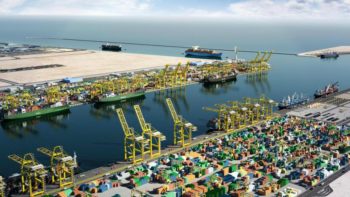
By Jite Eriabie
In the aftermath of the diplomatic fallout with its neighbours, Qatar has seen the number of vessel arrivals at its ports more than double from 29 vessels in June to 69 vessels in August, data from CargoSmart shows.
The sanctions imposed in June against Qatar saw air, sea, and land border connections with the country blocked by Saudi Arabia, the United Arab Emirates, Bahrain, and Egypt.
All Qatari-flagged ships or vessels destined for or arriving from Qatar were banned by its Arab neighbours.
As a result, Qatar was very busy over the period with the launching of new services that would circumvent its hostile neighbours.
The most recent activities saw an express service kick-started earlier this week by Yang Ming Line from Shanghai to Hamad port with the deployment of one ship with the capacity to carry 6,000 containers, including 400 reefer containers.
In addition, another line was launched in the Mediterranean by MSC and will be serviced by four ships, also with the capacity to carry 6,000 containers. The Mediterranean string starts at Turkish Mersin port linking Greece and Oman with the Port of Hamad and rounding up its trip in Mundra, India, as informed by Qatar’s Ministry of Transport and Communications
The effect of the Gulf crisis seems to have been subdued on Saudi Arabia’s vessel count as well, as the trend was similar to Qatar.
The vessel count stayed around 270 from March to July and then jumped to 313 in August. Again, the arriving vessels gradually increased over the past three months: 260 in June, 276 in July, and reached 313 in August, CargoSmart said.
The United Arab Emirates also had a similar trend. Its ports’ vessel count varied from 867 to 884 from March to May and then dropped to 752 in June. However, like Qatar and Saudi Arabia, the visiting vessels increased over the last three months, from 752 to 795.
During the period Qatari Hamad port had the longest vessel arrival and departure delays averaging 16 hours in June to 39.6 hours in July. Its average departure delay also increased from 9.45 hours in March to 27.7 hours in August.
“Overall, we found that the number of vessel arrivals dropped in June and then started to increase in July and August, the number of mega vessels visiting Saudi Arabia and the United Arab Emirates increased in August, and that Hamad Port in Qatar had the longest vessel arrival and departure delays among the terminals in July and August.
While the performance at the ports varied before and after the Qatar-Gulf crisis, it is not easy to identify if the crisis had a direct impact on the performance. The crisis started in early June, overlapping with Ramadan from May 26 to June 24, and was followed by the start of peak season for vessels transiting between Asia and Europe in late summer. Several factors may have influenced port and terminal performance,” the intelligence provider said.
The recently inaugurated Port of Hamad, is the largest port in the Middle East, with a basin of 4 kilometres in length, 700 meters in width and 17 meters in depth- specifications that allow for the development of the capability to host the world’s biggest ships.
Once completed, the port’s capacity is set to reach TEU 7.5 million per annum, while its general cargo terminal has the capacity of 1.7 million tons per annum.
The Gulf crisis also resulted in Hamad being connected to two Omani ports-Sohar and Salalah, Turkish Derince port, Pakistani Port of Karachi and Indian ports of Mundra and Nhava Sheva.